NVIDIA GeForce GTX 770 Review: The $400 Fight
by Ryan Smith on May 30, 2013 9:00 AM ESTAlthough GTX 770 is already a very high clocked part for GK104, we still wanted to put it through its paces when it comes to overclocking. Of particular interest here is actually memory overclocking, as this is the first video card shipping with 7GHz GDDR5 standard. This will let us poke at things to see just how far both the RAM itself and NVIDIA’s memory controller can go.
Meanwhile the switch to GPU Boost 2.0 for GTX 770 is going to change the overclocking process somewhat compared to GTX 680 and GTX 670. Overvolting introduces marginally higher voltages and boost bins to play with, while on the other hand the removal of power targets in favor of TDP means that we only get 106% – an extra 14W – to play with in TDP limited scenarios. Thankfully as we’ve seen we’re generally not TDP limited on GTX 770 at stock, which means our effective headroom should be greater than that.
| GeForce GTX 770 Overclocking | ||||
| Stock | Overclocked | |||
| Core Clock | 1046MHz | 1146MHz | ||
| Boost Clock | 1085MHz | 1185MHz | ||
| Max Boost Clock | 1136MHz | 1241MHz | ||
| Memory Clock | 7GHz | 8GHz | ||
| Max Voltage | 1.2 | 1.212v | ||
We’re actually a bit surprised we were able to get another 100MHz out of the GPU itself. Even without the extra overvoltage boost bin, we’re still pushing 1200MHz+ on 1.2v, which is doing rather well for GK104. Of course this is only a 9% increase in the GPU clockspeed, which is going to pale in comparison to parts like GTX 670 and GTX 780, each of which can do 20%+ due to their lower clockspeeds. So there’s some overclocking headroom in GTX 770, but as to be expected it's not a lot.
More interesting however is the memory overclock. We’ve been able to put another 1GHz on 6GHz GTX 680 cards in the past, and with the 7GHz base GTX 770 we’ve been able to pull off a similar overclock, pushing our GTX 770 to an 8GHz memory clock. The fact that NVIDIA’s memory controller can pull this off is nothing short of impressive; we had expected there to be some headroom, but another 14% is beyond our expectations. At this clockspeed the GTX 770 has a full 256GB/sec of memory bandwidth, 33% more than both a stock GTX 680 and the 384-bit GTX 580. Of course we’ll see if GTX 770 can put that bandwidth to good use.
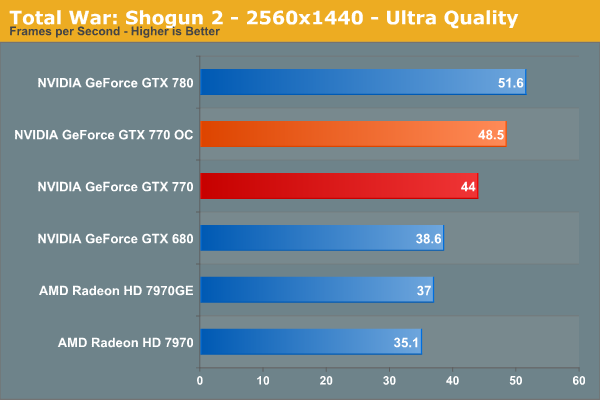
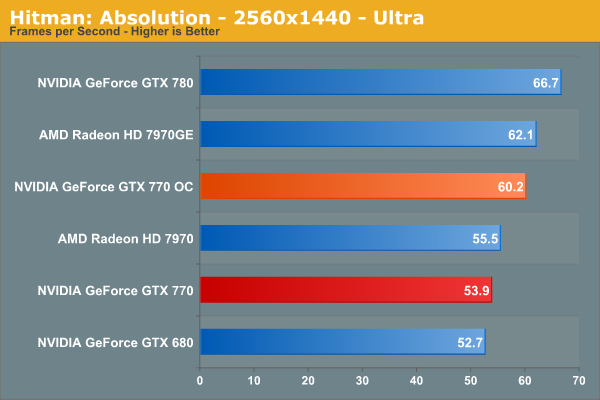
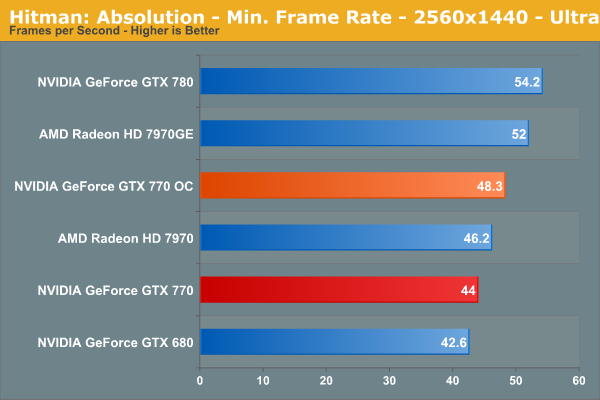
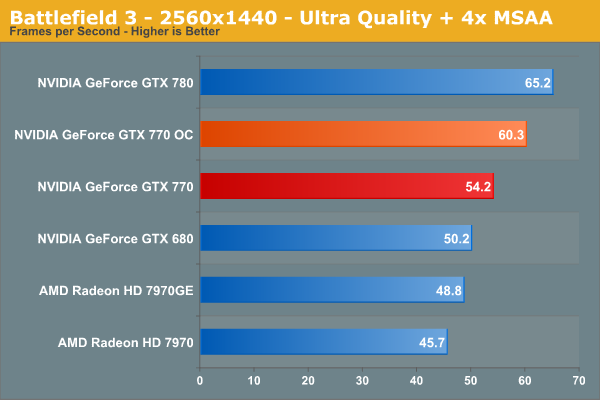
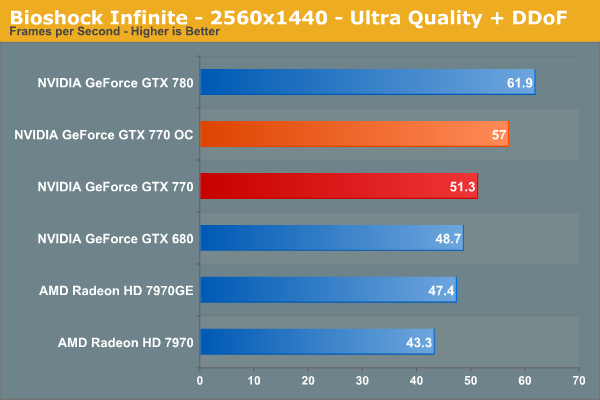
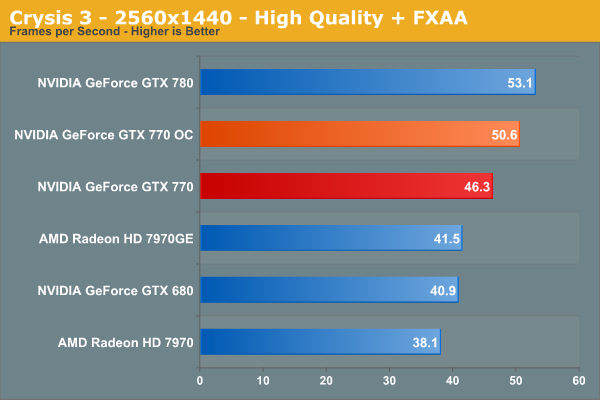
The end result of our overclocking efforts nets a very consistent 9%-12% increase in performance across our games. 9% is the upper bound for improvements due to GPU overclocking, so anything past that means we’re also benefitting from the extra memory bandwidth. We aren’t picking up a ton of performance from memory bandwidth as far as we can tell, but it does pay off and is worth pursuing, even with the GTX 770’s base memory clock of 7GHz.
Overall overclocking can help close the gap between the GTX 770 and 7970GE in some games, and extend it in others. But 10% won’t completely close the gap on the GTX 780; at best it can halve it. GTX 780’s stock performance is simply not attainable without the much more powerful GK110 GPU.
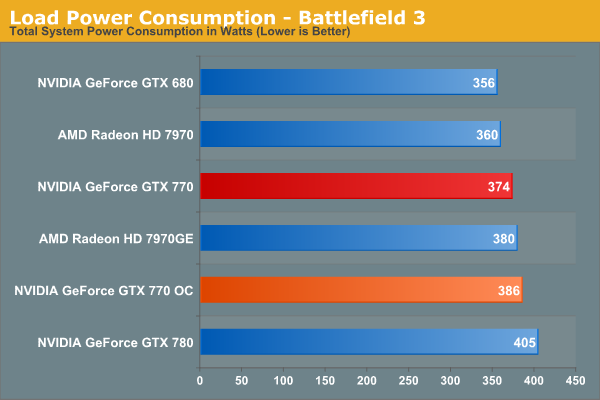
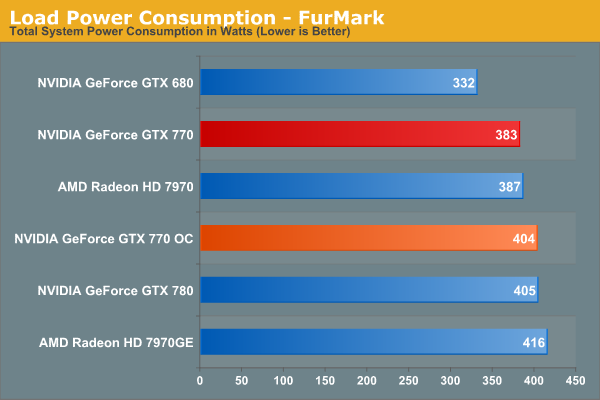
Moving on to power consumption, we can see that the 106% TDP limit keeps power usage from jumping up by too much. In Battlefield 3 this is a further 12W at the wall, and 21W at the wall with FurMark. In games this means our power usage at the wall is still below GTX 780, though we’ve equaled it under FurMark.
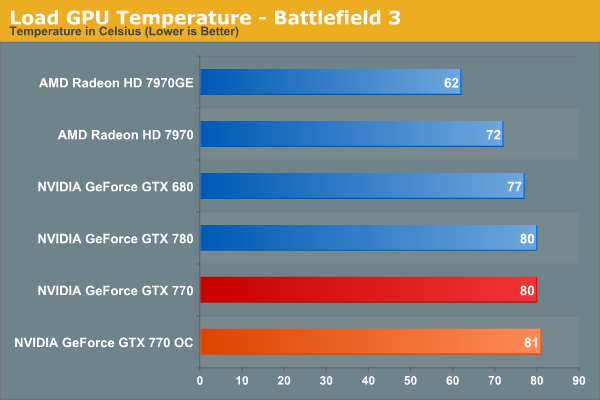
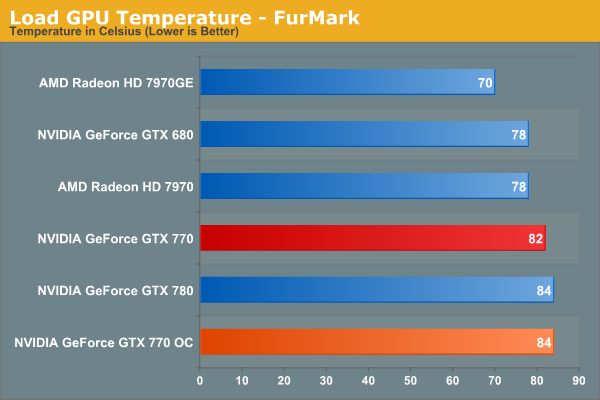
The fan curve for GTX 770 appears to be identical to that of GTX 780. Which is to say the fan significantly ramps up around 84C, keeping temperatures in the low-to-mid 80s even though GPU Boost 2.0 is allowed to go up to 95C.


Finally for fan noise, we see a small increase under Battlefield 3, and no change under FurMark. 1.5dB louder under Battlefield 3 puts noise levels on par with the GTX 780, sacrificing some of GTX 770’s abnormally quiet acoustics, but still keeping noise below the 50dB level. Or to put this another way, the performance gains for overclocking aren’t particularly high, but then again neither is the cost of overclocking in terms of noise.










117 Comments
View All Comments
raghu78 - Thursday, May 30, 2013 - link
what most of reviews. across a wide range of games and you will see these two cards are tied.http://www.hardwarecanucks.com/forum/hardware-canu...
http://www.computerbase.de/artikel/grafikkarten/20...
http://www.pcgameshardware.de/Geforce-GTX-770-Graf...
http://www.hardware.fr/articles/896-22/recapitulat...
bitstorm - Thursday, May 30, 2013 - link
It seems to match up with other reviews I have seen. Maybe you are looking at ones that are not using the reference card? The non-reference reviews show it doing a bit better.Still even with the better results of the non reference cards it is a bit disappointing of a release from Nvidia IMO. While it is good that it will likely cause AMD to drop the price of the 7970 GE but it won't set a fire under AMD to make an impressive jump on their next lineup refresh.
Brainling - Thursday, May 30, 2013 - link
And if you look at any AMD review, you'll see fanbois jumping out of the wood work to accuse Anand and crew of being Nvidia homers. You can't win for losing I guess.kallogan - Thursday, May 30, 2013 - link
barely beats 680 at higher power consumption. Turbo boost is useless. Useless gpu. Next.gobaers - Thursday, May 30, 2013 - link
There are no bad products, only bad prices. If you want to think of this as a 680 with a price cut and modest bump, where is the harm in that?EJS1980 - Thursday, May 30, 2013 - link
Exactly!B3an - Thursday, May 30, 2013 - link
I'd glad you mentioned the 2GB VRAM issue Ryan. Because it WILL be a problem soon.In the comments for 780 review i was saying that even 3GB VRAM will probably not be enough for the next 18 months - 2 years, atleast for people who game at 2560x1600 and higher (maybe even 1080p with enough AA). As usual many short-sighted idiots didn't agree, when it should be amazingly obvious theres going to be a big VRAM usage jump when these new consoles arrive and their games start getting ported to PC. They will easily be going over 2GB.
I definitely wouldn't buy the 770 with 2GB. It's not enough and i've had problems with high-end cards running out of VRAM in the past when the 360/PS3 launched. It will happen again with 2GB cards. And it's really not a nice experience when it happens (single digit FPS) and totally unacceptable for hardware this expensive.
TheinsanegamerN - Monday, July 29, 2013 - link
people have been saying that for a long time. i heard the same thing when i bought my 550 ti's. and, 2 years later....only battlefield 3 pushed ppast the 1 GB frame buffer at 1080p, and that was on unplayable setting (everything maxed out). now, if I lower the settings to maintain at least 30fps, no problems. 700 MB usage max. mabye 750 on a huge map. now, at 1440p, i can see this being a problem for 2 gb, but i think 3gb will be just fine for a long time.just4U - Thursday, May 30, 2013 - link
I don't quite understand why Nvidia's partners wouldn't go with the reference design of the 770. I've been keenly interested in those nice high quality coolers and hoping they'd make their way into the $400 parts. It's a great selling point (I think) and disappointing to know that they won't be using them.chizow - Thursday, May 30, 2013 - link
I agree, it feels like false advertising or bait and switch given GPU Boost 2.0 relies greatly on operating temps and throttling once you hit 80C.Seems a bit irresponsible for Nvidia to send out cards like this and for reviewers to subsequently review and publish the results.